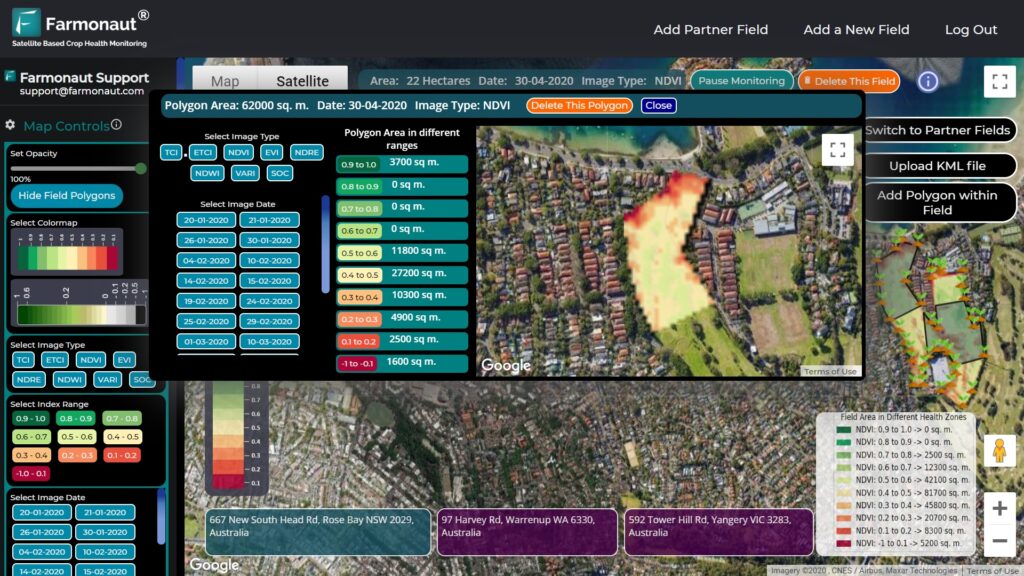Minnesota State Policies: 7 Powerful Impacts on Farmers & Economy
Table of Contents
- Introduction: The Complex Web of Minnesota State Policies & Federal Actions
- Background: State, Federal, and Tariff Dynamics Impacting Minnesota
- Impact Analysis Table: Minnesota State Policies & Federal Actions
- 1. The Impact of Tariffs on Minnesota Farmers & Export Markets
- 2. Effects of Executive Orders on Minnesota Agriculture and Research
- 3. Sanctuary Cities Policy: Funding, Immigrants, and Workforce Shifts
- 4. Diversity, Equity and Inclusion Policy in Minnesota: Opportunities and Threats
- 5. Immigration and Visas in Minnesota: Local Labor and Academic Diversity
- 6. Impact on Local Government Funding and Rural Development
- 7. Agricultural Research Programs: Cuts, Consequences, and Innovation Gaps
- The Farmonaut Perspective: Technology Solutions for Minnesota’s Agriculture
- Frequently Asked Questions: Minnesota State Policies, Tariffs & Farmers
- Conclusion: Navigating Unprecedented Change for Minnesota’s Farmers
Introduction: The Complex Web of Minnesota State Policies & Federal Actions
In recent years, Minnesota state policies, combined with federal government actions and global dynamics such as sweeping tariffs, have put unprecedented pressure on the state’s agricultural sector, local economy, diversity, immigration trends, and community well-being. As we examine these seven powerful impacts, it’s clear that the consolidation of executive power and shifting political priorities, especially in “blue” states like Minnesota, carry risks and rewards extending well beyond state boundaries.
We believe understanding the intricate relationships between state and federal policies, global trade wars, market access, and local government funding is essential for anyone invested in Minnesota’s present and future. From rapid changes via executive orders to the invisible yet impactful adjustments in research and grant allocations, every policy move affects our farms, our communities, and our shared prosperity.
Background: State, Federal, and Tariff Dynamics Impacting Minnesota
Minnesota, ranked 5th in the United States for cash receipts from farm products, occupies a critical space in the U.S. agricultural network. Our farmers depend heavily on export markets—notably to China and Canada—for the sale of soybeans, corn, and hogs.
The recent wave of executive orders from Washington, an aggressive trade campaign resulting in an ongoing trade war with China, and shifts in diversity equity and inclusion policy affect not only the commercial landscape but also the social fabric of communities across Minnesota. These changes have led to:
- Decreased international demand for Minnesota’s agricultural products
- Uncertainty over immigration and visas in Minnesota impacting labor and educational institutions
- Tension concerning federal funding—especially for sanctuary cities policy
- Ripple effects on our local economy, job stability, and innovation across rural and urban areas
Impact Analysis Table: Minnesota State Policies & Federal Actions
To support our analytical approach, we provide a direct, side-by-side comparison of the most influential policies, tariffs, and federal actions driving change in Minnesota today:
| Policy/Action | Affected Area | Estimated Positive Impact | Estimated Negative Impact | Brief Explanation |
|---|---|---|---|---|
| Minnesota State Farm Subsidy Adjustments | Local Economy, Rural Employment | +7% farm sustainability in some districts | -3% administrative overhead, -2% short-term confusion | Changes in distribution aim for more equity, but create transitional challenges for farm workers. |
| Trump-Era Tariffs on Agricultural Products | Agricultural Export Markets, Farmer Incomes | Potential +5% for small, protected domestic markets | -15% in export revenue, -12% on average commodity prices | Tariffs imposed on U.S. goods by China and others reduced overseas demand for MN crops. |
| Federal Funding Threats to Sanctuary Cities | Diversity, Local Programs, Economy | Minimal direct positive, +5% community advocacy | -10% city budgets, -8% on DEI and immigrant support programs | Threatened withdrawal of funds increases financial pressure on city budgets and programs. |
| Aggressive Executive Orders | State Bureaucracy, Research, Economy | +4% regulatory clarity for some sectors | Up to -15% delay in research, -6% higher operational uncertainty | Rapid policy swings disrupt university and agency planning. |
| Curtailed Refugee & Visa Programs | Labor Market, Academic Diversity | None measurable | -6% student body diversity, -7% skilled farm labor, -2% tuition income | Decreased international student enrollment and farm worker availability. |
| Cutbacks in Federal Grants/Research | Agricultural Innovation, University Research | Redirection to some commercial projects | -9% research output, -5% future farm innovation | Project halts and reduced research in Midwest agri-centers. |
| Reversal of DEI Policies | Cultural Inclusion, Workforce | Perceived +3% “unity” in some political factions | -10% inclusion programs, -4% minority retention/advancement | Limits on DEI reduce ability to attract/retain diverse talent. |
1. The Impact of Tariffs on Minnesota Farmers & Export Markets
Few actions have tested the resilience of Minnesota’s farmers as dramatically as the impact of tariffs on farmers over the past few years. Federal government actions intended to reclaim manufacturing jobs and “protect” American producers from perceived unfair trade have instead provoked retaliation from key partners like China.
The Tariff Ripple: From Soybeans to Corn
Minnesota’s dominance as an agricultural export market—particularly in soybeans, corn, and livestock—makes our state acutely vulnerable in any trade war with China. Tariffs imposed by both the United States and its trade partners directly reduced demand for Minnesota’s agricultural products abroad:
- Soybean exports plummeted by double-digits after China imposed new taxes on U.S. agricultural imports
- Tens of thousands of farm jobs faced uncertainty as international market access narrowed
- Local rural communities felt the pinch, as every dollar lost in farm income multiplies through local businesses and services
Despite some federal government compensation to offset early losses, our farm communities remain cautious. The volatility introduced by shifting tariffs makes long-term planning even more difficult, especially as other countries gain advantage in these newly disrupted markets.
Read more on how precision agriculture and remote monitoring can help Minnesota farmers adapt to unpredictable export conditions with Farmonaut Satellite Solutions.
2. Effects of Executive Orders on Minnesota Agriculture and Research
The current landscape is defined by the explosive use of executive authority. In only the first 100 days of President Trump’s new term, over 130 executive orders have been issued—starkly outpacing any prior administration. For Minnesota, with its vast research institutions and strong tradition of science-driven agriculture, the pace and unpredictability of these federal government actions is deeply disruptive.
Uninterrupted Change and Policy Whiplash
- Ongoing consolidation of federal power leaves state agencies and researchers struggling to keep pace
- Grants, university programs, and nonprofit funding are canceled or reduced without advance notice
- Scientific research projects—including those vital to agricultural productivity in Minnesota—face abrupt interruptions
As a result, our universities, extension offices, and agricultural research programs are facing both financial shortfalls and severe operational uncertainty. The net effect? Minnesota risks falling behind in the critical race toward sustainable, technologically advanced farming.
Want to ensure your farm’s data and planning is never left behind? Explore Farmonaut Satellite API and API Developer Docs for real-time, up-to-date agricultural monitoring.
3. Sanctuary Cities Policy: Funding, Immigrants, and Workforce Shifts
The sanctuary cities policy places Minnesota in direct conflict with the federal government, putting both funding and local law enforcement autonomy at risk. The aggressive stance taken toward sanctuary jurisdictions creates a climate of uncertainty for immigrants, city officials, and employers (especially within our agricultural workforce).
Sanctuary Cities Under Pressure
- The threat of federal prosecution or withdrawal of funds affects cities, counties, and even state agencies labeled as “sanctuary” jurisdictions
- Municipal budgets face up to 10% cuts on essential programs, including those supporting immigrant communities and DEI initiatives
- Local agricultural and service industries risk labor shortages, as fear of deportation reduces available workers and chills local hiring
The chilling effect also spreads to universities, nonprofit organizations, and local government programs that serve new arrivals and diverse communities. For an economy like Minnesota’s, which relies on a robust and diverse workforce, the long-term impact could be severe.
4. Diversity, Equity and Inclusion Policy in Minnesota: Opportunities and Threats
Diversity, Equity, and Inclusion (DEI) initiatives underpin much of Minnesota’s academic, economic, and social progress. However, the current administration has undertaken a campaign to limit or abolish such efforts, arguing that DEI policies are divisive.
Polarization and Community Resilience
- University and corporate DEI programs are threatened with defunding or legal challenge
- Minority students and workers face diminished opportunities for advancement, mentorship, and belonging
- The overall ability of Minnesota’s economy to attract and retain top talent is undercut by political instability and social tension
For Minnesota’s rural areas, the rise or fall of DEI policies has direct impacts: it affects which students enroll at our colleges, which researchers choose to set up labs in our state, and which global companies invest in our communities. A shrinking of these programs undermines our long-term growth prospects and economic diversity.
Looking for supply chain transparency designed for modern DEI and regulatory compliance needs? Discover Farmonaut Blockchain Traceability solutions—for agriculture, food, and more.
5. Immigration and Visas in Minnesota: Local Labor and Academic Diversity
Minnesota’s agricultural sector, research universities, and local economies have long depended on a steady influx of international talent—both immigrants working in the fields and students driving innovation in our labs.
Visa Revocations and Chilling Effects
- The Department of Homeland Security and ICE have revoked the visas of international students at Minnesota schools, destabilizing university finances and research collaborations
- Tightened immigration enforcement, arrests, and deportations reduce available seasonal and skilled labor for critical agricultural tasks
- Panic and uncertainty spread throughout the immigrant community, with visible impacts on mental health and participation in civic life
The reduction in both student and worker diversity limits our state’s ability to develop next-generation agricultural programs, compete globally, and address rural labor shortages. Ultimately, curtailing immigration and visas in Minnesota is a blunt policy instrument, risking long-term damage to the state’s innovation ecosystem.
For tools that can help Minnesota’s agricultural businesses optimize workforce scheduling and fleet efficiency despite shortages, explore Farmonaut Fleet Management.
6. Impact on Local Government Funding and Rural Development
The recent threat of substantial federal government funding cuts—targeting non-cooperative states and sanctuary jurisdictions—positions many Minnesota communities in a financial crisis.
Budget Shortfalls and Rising Pressures
- City and county programs—public health, education, social services—face shortfalls of up to 10% in annual budgets
- Rural areas are doubly impacted by reduced grant availability and market uncertainties for farm products
- Critical infrastructure investments, such as rural broadband, water safety, and local roads, are delayed or downsized
Governor Tim Walz has advised all state agencies reliant on federal funds to “assume it will be cut,” a blunt acknowledgment of the new normal. As rural communities and cities are forced to delay or cancel programs, Minnesota’s economic, educational, and health disparities could widen.
Discover scalable, automated solutions for large farm enterprises—get precision insights and resource monitoring on any scale with Farmonaut Large Scale Farm Management Tools.
7. Agricultural Research Programs: Cuts, Consequences, and Innovation Gaps
Reduced federal and state support for research is a silent yet profound threat to Minnesota’s status as an agricultural leader. With budget shortfalls, agency disruptions, and the redirection or elimination of vital grants, our farmers and agribusinesses lose access to the innovations that keep them globally competitive.
Research at the Crossroads
- University of Minnesota and affiliated agencies face significant cuts in grant funding and project support
- Programs investigating crop resilience, soil health, and climate adaptation are downsized or canceled
- The loss of international student and postdoc involvement further reduces the state’s research capacity
The compounding effects of lost funding, staff attrition, and community skepticism set Minnesota agriculture on a precarious path. Our ability to adapt to climate change, pests, and global market shifts depends on continuous investment in innovation.
Looking for actionable, research-driven data? Request Farmonaut Crop Loan and Insurance Verification to leverage satellite-backed insights for risk management and financing, even in challenging times.
The Farmonaut Perspective: Technology Solutions for Minnesota’s Agriculture
In the midst of national and state-level policy changes, access to real-time accurate information has never been more critical. This is where Farmonaut makes a transformative impact.
What Does Farmonaut Offer?
- Satellite-Based Crop Health Monitoring: Track NDVI, soil moisture, and crop anomalies across your fields with just a few clicks on your phone or computer.
- AI-Powered Advisory Systems: Get personalized recommendations driven by weather, soil, and crop data to mitigate risks associated with market volatility or resource shortages.
- Blockchain Traceability: Ensure all agricultural products meet quality, origin, and compliance expectations crucial in a world of disrupted trade.
- Fleet and Resource Management: Optimize the use of agricultural machinery and labor, streamlining operations in the face of workforce uncertainty.
- Carbon Footprinting: Accurately track your farm’s carbon emissions and unlock pathways to sustainability and future policy incentives.
Discover more: Farmonaut Carbon Footprinting
Farmonaut stands apart by making advanced precision agriculture tools accessible without expensive on-site hardware. Whether you manage a 20-acre family plot or a vast corporate farm, Farmonaut enables Minnesota producers to stay ahead of the curve—whatever the political weather brings.
Frequently Asked Questions: Minnesota State Policies, Tariffs & Farmers
How have tariffs specifically impacted Minnesota’s agricultural exports?
Recent tariff policies, especially in the context of the ongoing trade war with China, have led to a 15% decline in Minnesota’s agricultural exports. Soybeans, corn, and hogs—key staples for Minnesota farmers—have seen their overseas demand fall, reducing farm incomes and causing ripples throughout local economies.
What is the current outlook for sanctuary cities policy funding in Minnesota?
As of now, sanctuary cities and counties face threatened or enacted federal funding cuts. These policies aim to punish jurisdictions believed to resist cooperation with federal immigration enforcement, putting pressure on local governments to shift priorities and possibly reduce vital community programs.
Why are diversity, equity and inclusion policies under threat in Minnesota?
The current presidential administration regards DEI initiatives as divisive and is making aggressive attempts to halt their implementation across “blue” states like Minnesota. As a result, many academic, workplace, and community inclusion efforts risk losing funding and institutional support.
How are immigration and visa enforcement changes affecting Minnesota’s farms and universities?
Visa revocations and more aggressive federal enforcement lead to fewer international students and skilled agricultural laborers in Minnesota. This reduces not only labor availability, but also the diversity and vibrancy of both rural and educational communities.
How can technology, such as Farmonaut, support Minnesota agriculture during policy uncertainty?
Farmonaut offers satellite monitoring, AI advisory, blockchain traceability, resource management, and carbon footprinting solutions. These tools help Minnesota’s agricultural businesses optimize productivity, sustainability, and transparency, mitigating some effects of policy-driven uncertainty.
Can I access Farmonaut services on my mobile device?
Yes. Farmonaut is available via Android, iOS, and web/browser applications. Comprehensive farm monitoring is only a tap away.
Conclusion: Navigating Unprecedented Change for Minnesota’s Farmers
It is clear that the evolving Minnesota state policies, in tandem with disruptive federal government actions and aggressive tariffs, hold profound implications for every layer of our agricultural and economic ecosystem. From export markets and immigrant workforces to local government funding and DEI initiatives, the landscape is shifting faster than many can keep up.
Our analysis shows that while some short-term gains are possible, the overwhelming trend leans toward increased instability: market losses, funding gaps, and a narrowing of opportunities for Minnesota’s next generation of farmers, entrepreneurs, and students.
The agricultural economy can adapt—but only with access to timely information, leading-edge technology, and innovative tools. Rural communities, in particular, must remain vigilant and agile in adopting evidence-based strategies to compensate for shifting policies and uncertain times.
At Farmonaut, we are dedicated to supporting Minnesota’s agricultural enterprises, researchers, and governments with the precision, sustainability, and transparency needed to thrive—no matter what new policy tomorrow may bring.














